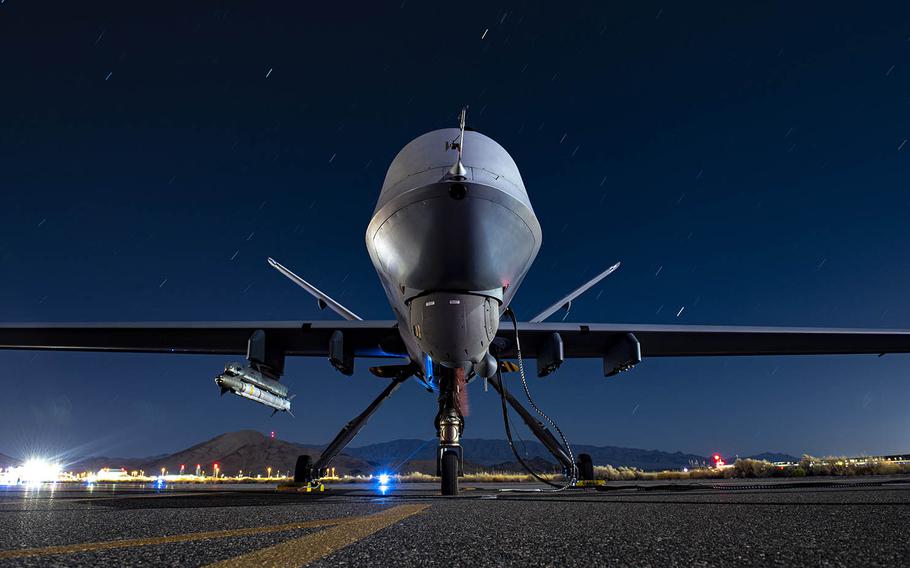
An Air Force MQ-9 Reaper armed with an AIM-9X Block 2 missile sits on the ramp at Creech Air Force Base, Nevada, Sept. 3, 2020. The drone is assigned to the 556th Test and Evaluation Squadron. (Haley Stevens/U.S. Air Force)
The Air Force has started using virtual reality to get hunter-killer drone pilots and sensor operators up to speed at Holloman Air Force Base, N.M.
Last month, trainees at the base began using Oculus Quest 2 headsets that allow them to simulate being in a drone cockpit, watching instructors remotely pilot an MQ-9 Reaper aircraft, according to the Air Force.
Reapers, made by General Atomics of San Diego, can carry 3,000 pounds of ordnance and first saw combat in Afghanistan in 2007 and Iraq the following year. They’ve conducted numerous missions there and in other parts of the Middle East and Africa.
A missile fired by one of the drones killed the commander of Iran’s Quds Force, Maj. Gen. Qassem Soleimani, when it struck his convoy near Baghdad International Airport.
The VR technology powering the Reaper training is provided by Moth + Flame, a Brooklyn, N.Y.-based company that has worked with the Air Force since 2019, the company’s chief operating officer Bryce Luken said in a telephone interview Friday.
Moth + Flame uses high-definition cameras and light detecting and ranging sensors, or LIDAR, to scan physical environments. It can add data feeds to virtual consoles and enhance parts of the environment to make students focus on them during training.
The first VR training that the firm provided for airmen involved maintenance procedures for C-130 airlifter models H and J and C-5M cargo planes, F-15 Eagle fighter models C and E and E-8 command and control aircraft.
The use of VR for maintenance training saved the Air Force time, fuel and travel costs, Luken said.
Next the company developed virtual suicide awareness and prevention training for airmen, he said. Now the Air Force is rolling out VR at Holloman, where 700 drone operators qualify each year.
The first phase of what is intended to be widespread use of the technology for drone training involves 43 VR headsets that 60 students can use to get an idea of how things work in the cockpit during operations, said Capt. John Grice, an MQ-9 instructor at Holloman.
“What we have in the hands of students is not set up to mimic actually piloting aircraft,” he said during Friday’s telephone interview. “It is more of an observing type of thing … like they are standing in the cockpit.”
A drone cockpit is a ground station where operators use screens and controls to maneuver the aircraft, which could be anywhere in the world, via data links.
The realism of the VR simulation is “phenomenal,” said Grice, who has operated drones for five years, including on missions in the Middle East.
Drone piloting is easier to simulate, he said, because there are none of the G-forces or equilibrium changes that conventional aircraft crews experience.
The technology is being used to prepare students for their first session in a Reaper simulator.
Most of the trainee drone operators have tried out virtual reality video games but haven’t used the technology for work, Grice said.
The goal is to expand the VR training to allow students to practice the full gamut of skills they need to operate a drone, from flying to emergency procedures and hand-over operations, he said.
“Everything from how to turn the aircraft left and right to dropping a bomb on someone’s forehead at a specific time,” he said.
Moth + Flame’s goal is to be the Air Force’s technology partner, Luken said. The technology can cut the time it takes to train students and the resources needed to train them.
“We take the training they do in the classroom and put it into the VR domain to create the same level of training or enhance it,” he said.
robson.seth@stripes.com Twitter: @SethRobson1